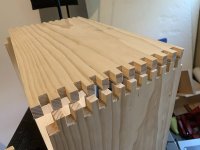I thought this would have been finished earlier this week but no... I had cut a beautiful baffle for it, pained it, put grill cloth and piping on it - then found the speaker wouldn't clear the amp! D'oh!
So: cut another baffle, glue and screw the spacers for the grill, paint matt black, leave overnight, add grill cloth and piping and voila - done. It's all quite cozy inside but nothing touches anything it shouldn't. The cab is solid pine finger-jointed like a tweed cab and I think it has really helped remove the boxiness that these amps can suffer from sometimes. It's also quite a bit lighter in weight which always a bonus. Speaker is a Celestion G12H Creamback - a favourite of mine. Really proud of the extremely low noise floor.

Damn - I must wipe those dusty fingermarks off it!

So: cut another baffle, glue and screw the spacers for the grill, paint matt black, leave overnight, add grill cloth and piping and voila - done. It's all quite cozy inside but nothing touches anything it shouldn't. The cab is solid pine finger-jointed like a tweed cab and I think it has really helped remove the boxiness that these amps can suffer from sometimes. It's also quite a bit lighter in weight which always a bonus. Speaker is a Celestion G12H Creamback - a favourite of mine. Really proud of the extremely low noise floor.

Damn - I must wipe those dusty fingermarks off it!




